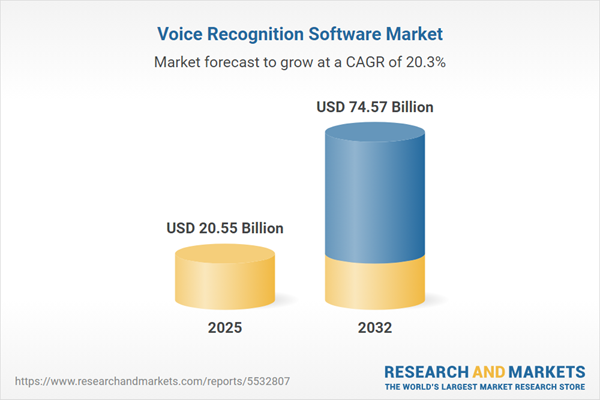Speak directly to the analyst to clarify any post sales queries you may have.
Voice recognition software is redefining how enterprises address business process automation, security, and compliance. As organizations advance digital transformation initiatives to maintain a competitive edge, deploying intelligent voice-enabled platforms streamlines critical workflows and supports rapid decision-making across fast-changing markets.
Market Snapshot: Voice Recognition Software Market Analysis
The global market for voice recognition software is experiencing significant growth as enterprises embrace advanced artificial intelligence solutions to meet operational demands. Recent analysis indicates the sector is set to achieve USD 20.55 billion in 2025 from USD 17.02 billion in 2024, with a robust compound annual growth rate (CAGR) of 20.27%. Forecasts suggest continued expansion, reaching USD 74.57 billion by 2032. Key market drivers include widespread digitalization, accelerated innovation, and heightened priorities for automating essential business operations. Organizations focusing on digital transformation are leveraging these technologies to enhance agility, ensure compliance, and meet customer and regulatory expectations within a dynamic enterprise environment.
Scope & Segmentation: Comprehensive Industry Coverage and Technology Landscape
- Component: Advanced sensors, high-performance processors, and intelligent software form the infrastructure for robust voice recognition platforms, supporting seamless integration and more efficient business workflows.
- Technology: Solutions range from speaker dependent systems, offering secure user authentication, to speaker independent options that enable inclusive collaboration for diverse teams and multisite operations.
- Application: Voice technologies are being adopted in automotive infotainment, healthcare documentation, financial fraud detection, retail operations, and IT services, driving more consistent communication and process automation.
- End User: Large enterprises benefit from improved operational efficiency and streamlined internal communications, while individual professionals utilize hands-free features for greater workflow flexibility.
- Deployment Mode: Enterprises can select between cloud-based or on-premises implementations according to their compliance policies, scalability targets, and data management preferences.
- Regions: Adoption trends are notable in China, India, Japan, and Australia, driven by digital policies, while substantial growth also continues across the Americas, Europe, Middle East & Africa, and Asia-Pacific due to ongoing technology investments.
- Key Companies: Market leadership is demonstrated by organizations such as DeepScribe Inc., Microsoft Corporation, Renesas Electronics Corporation, Google LLC, Apple Inc., IBM, Speechmatics Limited, VoicePower Ltd, SpeechWrite Ltd, and Phonexia s.r.o., each contributing to innovation and best practices with regionally tailored strategies.
Key Takeaways for Strategic Decision-Making
- Deep learning capabilities support secure collaboration within remote and distributed work environments, aligning with evolving enterprise work models.
- Multilingual and context-aware features promote inclusive communications, allowing organizations to connect geographically dispersed teams and support global expansion strategies.
- Interoperability with cloud and edge computing enhances data protection and operational agility, ensuring rapid response to organizational needs and workflow shifts.
- Integration into core sectors like healthcare and finance raises compliance levels and supports advanced risk management frameworks for critical business functions.
- Automated voice-driven processes heighten customer interactions, allowing technology investments to align with enterprise performance goals and measurable outcomes.
- Privacy-by-design principles embedded within software influence data governance alignment and prepare organizations for new global compliance requirements.
Tariff Impact: Supply Chain Strategies and Operational Resilience
New tariffs on key hardware components, including semiconductors, are influencing how organizations approach procurement and supplier relationships in the voice recognition software sector. To increase operational resilience, many enterprises are moving to nearshoring, diversifying supplier networks, and adopting modular technology architectures. These measures enable businesses to withstand trade policy changes and supply chain disruptions while maintaining operational continuity.
Methodology & Data Sources
This market analysis is based on diverse sources, including industry data, regulatory documents, executive interviews, and targeted surveys. Each finding is verified through thorough triangulation and peer-review to deliver actionable insights that support sound strategic decisions.
Why This Report Matters
- Helps senior decision makers align voice recognition software investments directly with their organization’s security, regulatory, and operational objectives for maximum value.
- Provides an actionable view of technology deployment options, compliance strategies, and risk management frameworks relevant to enterprise-scale adoption.
- Identifies emerging supply chain challenges and equips organizations with practical strategies for risk mitigation and sustained business continuity.
Conclusion
Leveraging voice recognition software enables organizations to accelerate efficiency and achieve consistent compliance. Strategic investment in these solutions positions enterprises to navigate evolving regulatory and technology landscapes with confidence.
Additional Product Information:
- Purchase of this report includes 1 year online access with quarterly updates.
- This report can be updated on request. Please contact our Customer Experience team using the Ask a Question widget on our website.
Table of Contents
3. Executive Summary
4. Market Overview
7. Cumulative Impact of Artificial Intelligence 2025
Companies Mentioned
The companies profiled in this Voice Recognition Software market report include:- DeepScribe Inc.
- Microsoft Corporation
- Renesas Electronics Corporation
- Google LLC
- Apple Inc.
- International Business Machines Corporation
- Speechmatics Limited
- VoicePower Ltd
- SpeechWrite Ltd
- Phonexia s.r.o.
Table Information
| Report Attribute | Details |
|---|---|
| No. of Pages | 198 |
| Published | November 2025 |
| Forecast Period | 2025 - 2032 |
| Estimated Market Value ( USD | $ 20.55 Billion |
| Forecasted Market Value ( USD | $ 74.57 Billion |
| Compound Annual Growth Rate | 20.2% |
| Regions Covered | Global |
| No. of Companies Mentioned | 11 |









